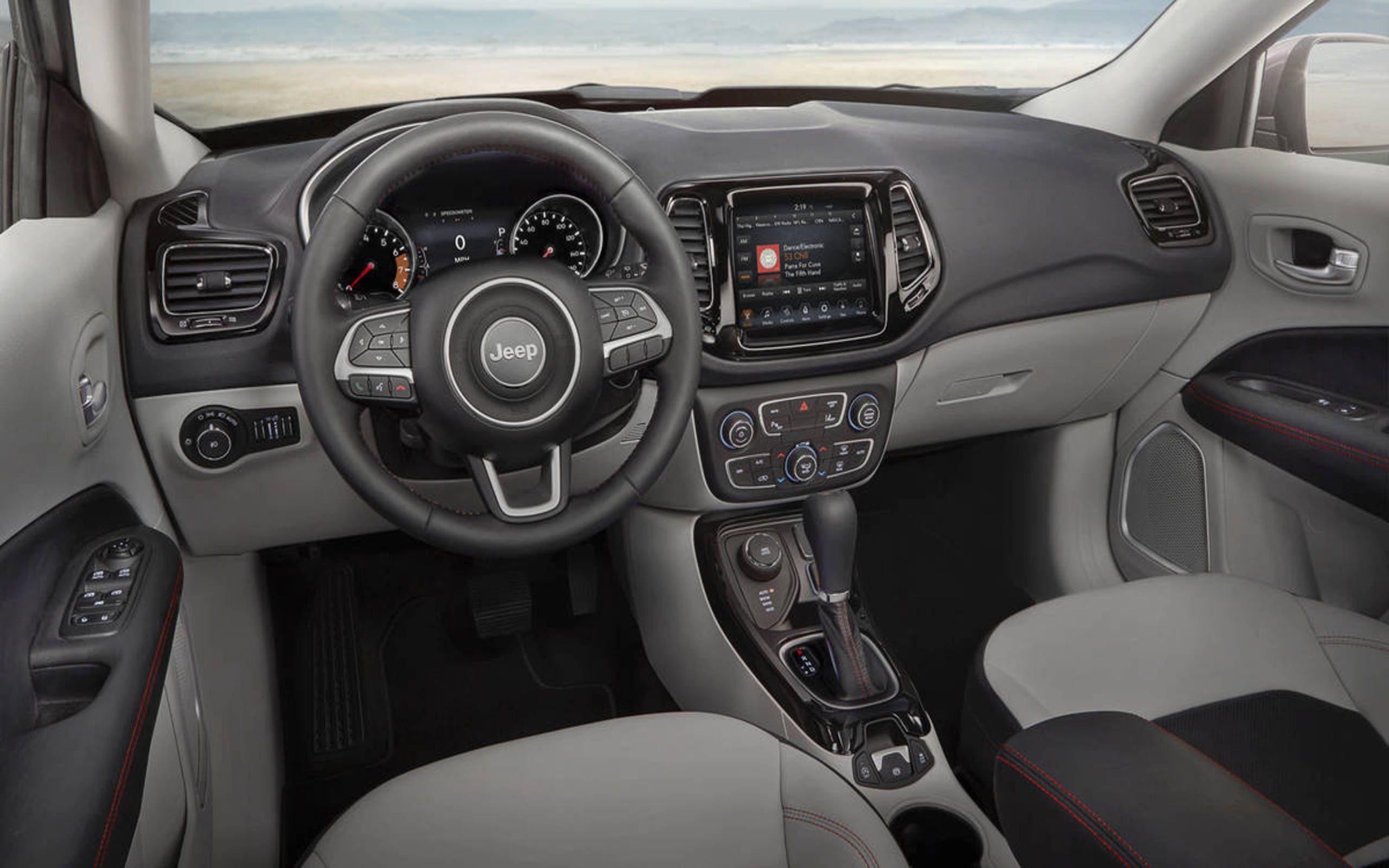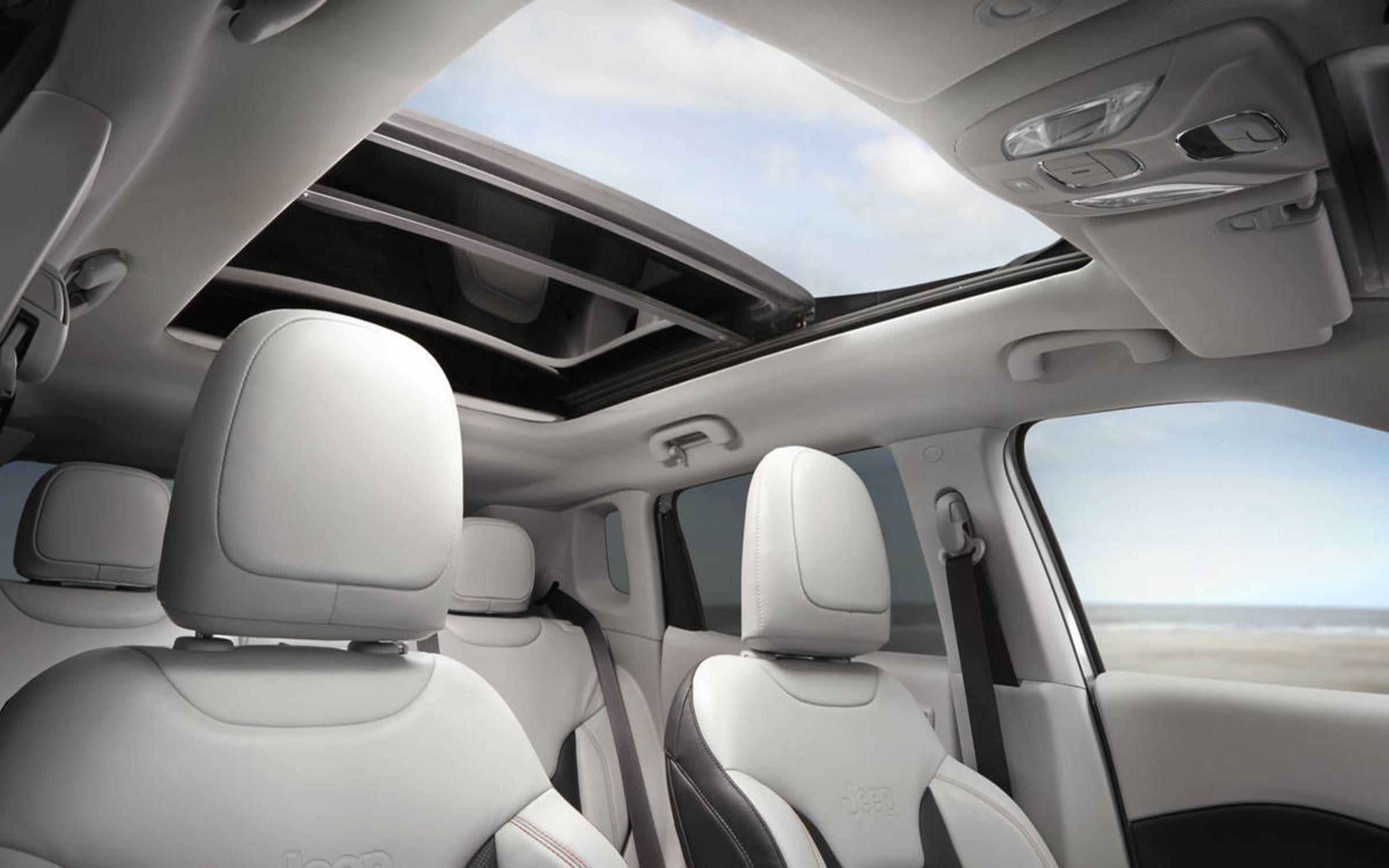2017 Jeep Compass Latitude 4 Wheel Drive System
It's a good time to be a brand that specializes in SUVs. Just about anything that appears tall or trucky becomes an instant hit in today's market. Since everything Jeep makes is both tall and trucky, sales at Jeep stores have surged -- the brand sold nearly a million vehicles in the U.S. last year.
"The Jeep brand is really becoming an SUV destination for shoppers," says Jeep brand director Scott Tallon. "Regardless of the price point or size, there's a number of different models to select from."
Subcompact crossovers are one of the hottest (and least expensive) slivers of the segment, and Jeep found garages for 106,606 of their cute and spunky Renegades last year, making it the best seller in this new class. Engineers took the successful bones of that vehicle to create an all-new second-generation Compass. In fact, the vehicles are produced together in the company's Toluca, Mexico, plant.
"Quite frankly, our timing couldn't be any better to launch this vehicle," says Tallon. "You want to be established so when that (SUV) growth starts to mature and plateau off, you aren't the new guy trying to prove yourself."
That old first-generation Compass lasted a full 10 model years, with one facelift in 2011. That's an incredibly long run, yet in its final year, Jeep moved more of them than any before -- almost 100,000. That speaks to the strength of the Jeep brand and the market itself. Still, this was one crossover long overdue for a freshening.

Jeep
"Both vehicles have very distinct personalities," says Tallon. "The Renegade is more Wrangler-focused, with lots of right angles and round headlights, whereas the Compass is clearly taking styling cues from the Grand Cherokee, so it's more sleek and progressive."
Indeed, you could argue the new Compass's design looks more traditionally "Cherokee" than the current small Cherokee does. Dimensionally, the Compass has been engineered to fill a relatively narrow space in between the Renegade and Cherokee. So compared to a Renegade, the wheelbase was stretched by 2.6 inches to 103.8 inches, and overall length expanded by more than 6 inches. Predictably, these moves provide more room for people and stuff inside, with a whopping 4.3 inches more legroom (39.4 inches) in the rear seat and 4.2 cubic feet more cargo space behind the rear seats (22.7 cubic feet). Because the Compass roofline is chopped by about 2 inches compared to the blocky Renegade, rear-seat headroom takes a hit by the same amount. If you want to wear a ten-gallon hat while driving your small Jeep, get the Renegade. And the Compass is, in many ways, a mechanical duplicate to the Renegade sharing its four-wheel independent suspension system, electric power-steering system and disc brakes.
Jeep is proud that the new Compass is a global vehicle. It will have 17 powertrain combinations sold in 100 countries on four continents. The rest of the world might have interesting options like torquey turbo-diesels, but here, there's just one gasoline engine. The Compass uses FCA's 2.4-liter "Tigershark" four-cylinder producing 180 hp at 6,400 rpm and 175 lb-ft of torque at 3,900 rpm. Sport and Latitude trim-level models use either a six-speed manual or six-speed automatic with the option of a nine-speed automatic. But the better-equipped Trailhawk and Limited come standard with the nine-speed. And that combination delivers a respectable 22 mpg city and 30 mpg highway, according to the EPA.
Front-wheel drive is standard, but this is a Jeep, so of course there are two optional 4WD systems. Active Drive is a full-time system with a rear axle disconnect to allow front-drive or all-wheel drive when the system senses conditions require it. And it comes with a Select-Terrain knob so drivers can dial in modes for snow, sand and mud, where up to 12 parameters -- including stability control, traction control and transmission performance settings -- are adjusted to suit the terrain. Or drivers can just leave the system in auto and let the computers do what they do best.
Active Drive Low is the one you want for more serious off-road work, and it's only available on Trailhawk models. The system has all the aforementioned settings plus a more aggressive rock mode. Now, the "Low" in Active Drive Low doesn't really mean it has a low-range gear reduction like more serious 4X4s. No, here "Low" means there's a numerically higher final drive ratio that provides a better (lower) 20.4:1 crawl ratio, versus the standard 17.6:1 on other nine-speed 4WD Compass'. Translation? The Trailhawk can creep along off-road with slightly more control than your average Compass. The Trailhawk not only comes with a unique 4WD system and more aggressive styling, including those trademark bright red tow hooks, but also a 1-inch taller ride height and skid plating all along the underside protecting nearly every component.
The Compass is available in three other models, too: Sport, Latitude, and a more luxurious Limited. The majority of the technology and luxury options begin to become available in the Latitude models. But strangely almost all of it remains optional all the way up to the Limited model. The Safety and Security Group includes blind-spot monitoring, rear cross path detection, park assist and more. The Advanced Technology Group brings forward-collision warning, lane-departure warning and HID headlamps. The Navigation Group will likely be one of the most popular options because it replaces the 5- or 7-inch (depending on model) infotainment screen with a big 8.5-inch touchscreen display.

The Navigation Group is likely to be one of the most popular options because it replaces the 5 or 7-inch (depending on model) infotainment screen with a big 8.5-inch touchscreen display.
Jeep
The Execution
The Compass might be several inches longer than the Renegade is, but it's only about 60 pounds heavier, so the reasonably athletic personality of Jeep's smallest rig is preserved here, too. In fact, the engineering team says they were aiming to increase refinement and provide a slightly sportier ride overall compared to the Renegade. Much of that comes from revisions in shock damping. The Compass is certainly an easy vehicle to hustle along a mountain pass, which we learned during a drive in Northern California. It feels nimble and light on its feet. However, the brakes are a little grabby in the first few inches of pedal travel. The vehicles on our drive were early production vehicles, so perhaps the brake-pad spec was yet to be finalized.
The 2.4-liter four-cylinder engine helps the Compass move adequately, but some of Jeep's competitors with similar engine outputs feel stronger, with a bit more refinement. And a few, like the Kia Sportage, offer a more potent engine option with over 200 hp. Every vehicle Jeep had on hand for this drive used a nine-speed automatic. This transmission should be the shining star of the whole powertrain, and if you want to hypermile, that's probably true. But the gearbox appears tuned to maximize fuel efficiency all the time. It loves to loaf along in the top gears -- fine for freeway cruising, but it takes a heavy boot to initiate a few downshifts, and the tuning detracts from the fun of this powertrain. Jeep offers multiple modes for its 4WD systems, so why not also add a "sport" mode for this transmission?
Slide into the back seat and it's reasonably comfortable for a 6-foot adult. There's no lack of legroom, to be sure. However, our particular Limited was equipped with the dual-pane sunroof, which cut into headroom back there. If you plan to carry tall adults in that backseat with some frequency, skip the sunroof.

The Compass's roofline is chopped by about 2 inches compared to the blocky Renegade, so rear seat headroom takes a hit by the same amount.
Jeep
Our pavement drive ended about an hour south of San Jose at one of California's best off-road parks, Hollister Hills State Vehicular Recreation Area. Hollister has 24 miles of trails so there's plenty of fun for 4WD vehicles of all capability levels. Jeep sidelined the Limited model we had been driving and swapped us into a Compass Trailhawk. For the first run on Jeep's trail course, we left the 'Hawk's 4WD system in Auto mode on the rutted dirt trails but switched to 4WD Lock. Engaging the "Lock" doesn't actually lock the 4WD system in a 50 percent front, 50 percent rear torque split like a traditional 4X4. Instead, it pre-conditions the 4WD system by making it ready to accept varying amounts of rear-drive torque to the rear-differential module. Essentially, it lets the torque transfer happen milliseconds quicker than it would without the lock engaged. And it all works very well, expertly managing traction on some fairly challenging climbs.
"We actually reduce the torque as we encounter an obstacle so we don't slip a tire," says Jeep Compass engineering vehicle line executive Art Anderson. "It's all about finesse. It's about being able to meter in the right amount of torque to get over an obstacle."
On the next trail section, we selected rock mode. Anderson says the traction-control system is on a much more aggressive schedule. And we noticed it only took about a half of one complete tire rotation to arrest the wheelspin and pull us through. The Compass Trailhawk does have limitations -- it won't follow a Wrangler or even a Cherokee Trailhawk on more serious excursions, but there's nothing in this size or price class that provides the breadth of capability of the little Compass Trailhawk.
The Takeaway
If off-road capability is a priority, there's little doubt the Compass Trailhawk is the most fun to look at and the best one for bashing around dirt trails. But the marketplace is flooded with crossovers. And many of the ones the Compass competes with offer a more refined powertrain. That said, perhaps the sweetest Compass of all to drive on the street will end up being one of the manual transmission models. If it's a pavement-only Compass, make ours a manual Latitude and load it with options.
Vehicle Model Information
ON SALE: March 2017
BASE PRICE: $22,090
POWERTRAIN: 2.4-liter I-4, six-speed manual, six-speed automatic, nine-speed automatic
OUTPUT: 180 hp @ 6,400 rpm; 175 lb-ft of torque @ 3,900 rpm
CURB WEIGHT: 3,184 lbs. (2WD Sport) to 3,633 lbs. (4WD Trailhawk)
FUEL ECONOMY: 23 mpg city, 32 mpg highway (manual 2WD), 22 mpg city, 31 mpg highway (manual 4WD, six-speed automatic 2WD), 22 mpg city, 30 mpg highway (nine-speed 4WD)
PROS: Crisply styled, off-road capable, nimble handling
CONS: Lethargic transmission response, touchy brakes
This content is created and maintained by a third party, and imported onto this page to help users provide their email addresses. You may be able to find more information about this and similar content at piano.io
2017 Jeep Compass Latitude 4 Wheel Drive System
Source: https://www.autoweek.com/drives/a1814811/2017-jeep-compass-first-drive/